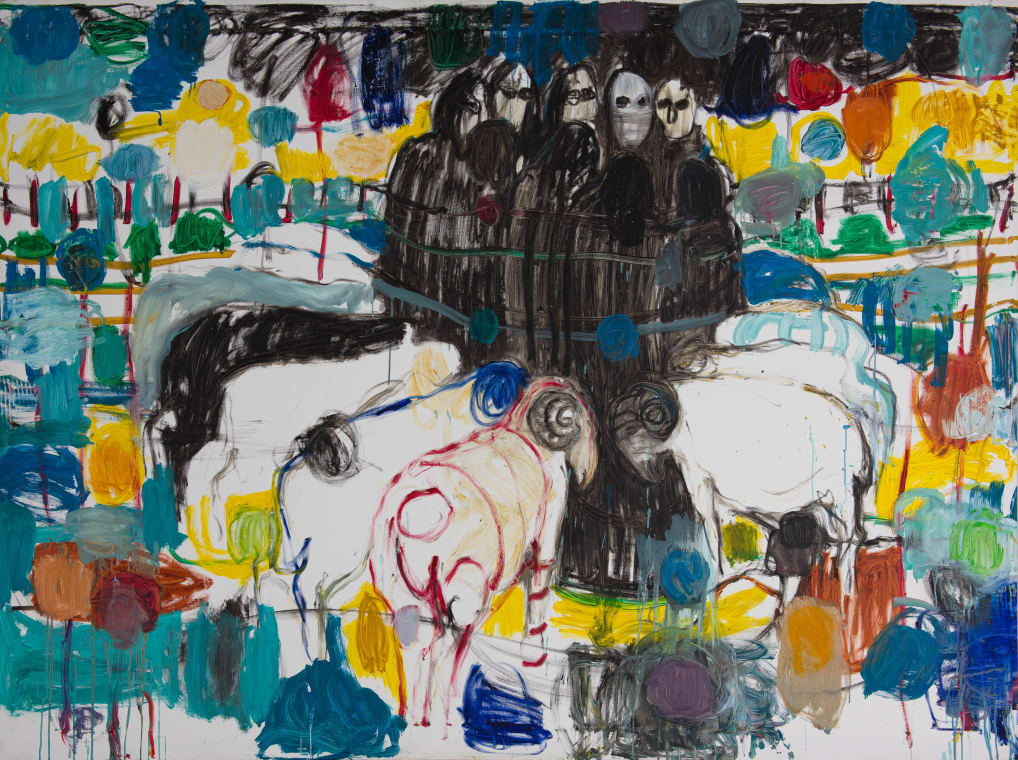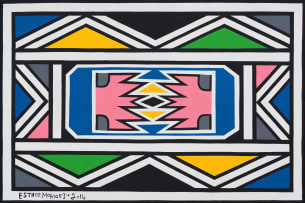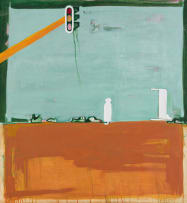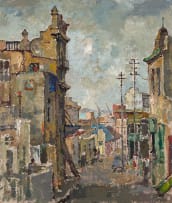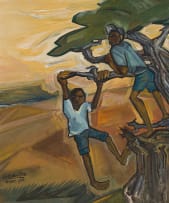Evening Sale
Live Virtual Auction, 17 September 2024
Evening Sale: Modern and Contemporary Art
About this Item
signed and dated 2014
Provenance
blank projects, Cape Town.
Private Collection.
Exhibited
blank projects, Cape Town, Life Sentence, 3 April to 3 May 2014.
Notes
"Masamvu's palette is equally uneasy and combative, combining patches of bright primary colours with acidic tones and monochrome scrawl, the surfaces scratched raw by dry brushes or left untreated with seeming disregard which belies a confidence in the formal execution of these works"1
Misheck Masamvu came to global prominence when six of his colour-rich figurative paintings appeared in Zimbabwe's first national pavilion at the 54th Venice Biennale in 2011. His presentation attracted numerous offers to exhibit in Europe, but Masamvu turned these down in favour of a residency at Greatmore Studios, Cape Town. "I wanted to remain independent. I felt I didn't have enough."2 In Cape Town, Masamvu met dealer Jonathan Garnham. This led to two solo exhibitions with blank projects. This work appeared in Masumvu's second exhibition, in 2014, and was prominently displayed near a street-facing window.
The work presents a tightly packed figural grouping (black-robed figures defensively surrounded by rams) surrounded by a patchwork of simple colours overlaid onto an incomplete grid. Masamvu tends to use the figure as both a formal and metonymic device to occupy and activate a painterly space. His vibrant and atavistic style forms part of a lineage of expressionistic figure painting from Zimbabwe that includes Thomas Mukarobgwa and Kingsley Sambo. Curator Frank McEwen coined the phrase "Afro-German expressionism" to account for Mukarobgwa's widely admired work of the 1960s.3 Masamvu's work slots into this lineage but also claims its own distinct genealogy.
In 1999, Masamvu participated in a Gallery Delta workshop led by visiting German-American painter Jerry Zeniuk, and later, in the mid-2000s, won a scholarship to study under this colour-interested painter at Munich's Academy of Fine Arts. Masamvu's German education shows in his phenomenological approach to colour and strategy of incompletion. It ultimately also prompted the artist to move away from his earlier, graphically political work towards producing "charged figural allegories characterized by their scruffy luxuriance."4
"I usually combine together many emblems and motifs," said Masamvu in 2011. "I'm very aware of the multi-layers that actually exist in my works and these layers are the things I want people to discover while they look at my paintings. I want them to relate to these elements in an emotional way. The subject matter may not be really direct, but it is inspired by themes such as relationship and hierarchy."5 This work extends on these formal and conceptual working concerns.
1. blank projects, Life Sentence Exhibition Statement, online, https://blankprojects.com/Life-Sentence, accessed 12 August 2024.
2. Sean O'Toole (2018) unpublished interview with artist, Johannesburg, 20 March
3. Sidney Littlefield Kasfir (1999) Contemporary African Art, London:Thames & Hudson, page 71.
4. Sean O'Toole (2019) 'Misheck Masamvu', Artforum, online, https://www.artforum.com/events/misheck-masamvu-245395/, accessed 12 August 2024.
4.Anna Battista (2011) 'Venice Biennale 2011: Zimbabwe Pavilion', Dazed, 16 June, online, https://www.dazeddigital.com/artsandculture/article/10610/1/venice-biennale-2011-zimbabwe-pavilion, accessed 12 August 2024.
Literature
Africanah (2015) Misheck Masamvu, online, https://africanah.org/misheck-masamvu-zimbabwe/, accessed 1 August 2024, illustrated.
OnCurating (no date) Interview with Misheck Masamvu by Olga Speakes, online, https://www.on-curating.org/issue-32-reader/mishek-masamvu.html, accessed 1 August 2024, illustrated.
